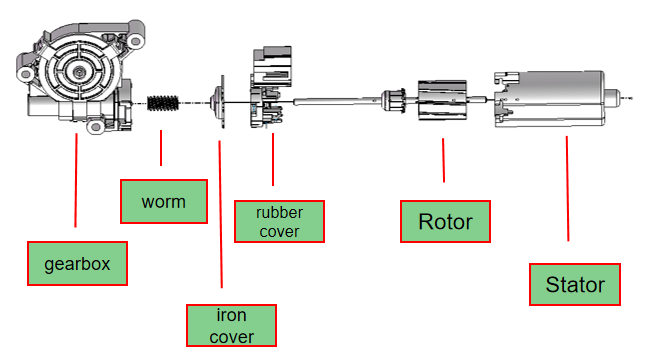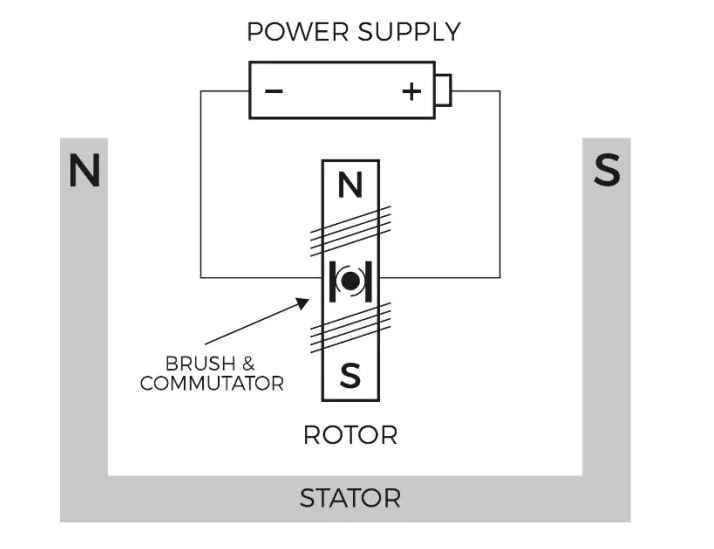Generally, motors can be divided into direct current motors and alternating current motors based on the power supply. And according to whether they have brushes or not, DC motors can be divided into brushed DC motors and brushless DC motors.
The article will introduce brushed direct current motors on the structure, working principle, advantages, and disadvantages of control drive methods, and so on.
The Structure of Brushed DC Motors
Brushed DC motors mainly consist of three components: stator, rotor, and end shields.
A. Stator: As the stationary part of the motor, it includes a shell, magnets, bearings, and magnet brackets. And the shell is usually made of high-temperature-resistant, high-strength materials to protect the internal magnets and bearings. The magnetic steel is responsible for generating a constant magnetic field, while the bearings ensure the smooth operation and durability of the motor;
B. Rotor: As the rotary part of the motor, it mainly consists of rotor stamping, insulation materials, enameled wires, commutators, rotating shafts, and sleeves. The rotor stamping and insulation material together form the armature. The enameled wire is wound into a coil and fixed on the armature. The commutator is responsible for switching the direction of the current during the rotation of the rotor;
C. End Shields: They are used to enclose the motor, protect its internal components, and provide brushes and commutators support. Carbon brushes and EMC components are also installed on the end shields to ensure the motor's stable operation.

The Working Principle of Brushed DC Motors
The working principle of a brushed DC motor is based on the law of electromagnetic induction. The motor stator is equipped with a pair of DC-excited stationary main magnetic poles, and the motor rotor is equipped with an armature core. In the air gap between the stator and the rotor, an armature coil connected by two conductors is placed on the armature core. The first and end shields of the coil are connected to two arc-shaped copper sheets. The copper sheet is called a commutator piece. The commutator segments are insulated from each other, and the whole composed of the commutator segments is called a commutator. The commutator is fixed on the rotating shaft, and the commutator segments and the rotating shaft are also insulated from each other. There is a pair of fixed ones placed on the commutator segments. When the armature rotates, the armature coil is connected to the external circuit through the commutator segments and brushes.

The Advantages of Brushed DC Motors
1. The speed of response is fast, the starting torque is big, and the shifting performance is steady;
2. Excellent torque performance at low speed, able to provide large starting torque;
3. Compared with brushless DC motors, its structure is simpler and its price is lower;
4. It avoids the effects of sensor interference, electronic parts failure, and so on, and the maintenance difficulty is relatively low;
5. The structure is relatively simple, and the manufacturing cost and use costs are low.
The Disadvantages of Brushed DC Motors
1. The friction between brushes and commutators will cause some problems such as reduced efficiency, increased noise, and easily emit heat, thus influencing the working life of the motors;
2. The resistance is large, the efficiency is relatively low, and the output power is small;
3. The friction between the brush and the commutator will cause sparks, which will interfere with nearby electronic components and signals and affect the work.
Things to Notice When Designing Brushed DC Motors
1. Select appropriate driver components: When designing a motor drive circuit, you need to select an appropriate gate driver IC or a motor driver IC that integrates a power switch and driver;
2. Consider the motor’s current and voltage specifications: When designing, you need to ensure that the driver can handle the motor’s current and voltage requirements;
3. PWM drive and speed control: Using pulse width modulation signals to control motor speed, the frequency and duty cycle of the PWM signal need to be considered;
4. Loss and switching strategy: Under PWM drive, you need to pay attention to the loss and switching method. Losses during the steady-state period are mainly conduction losses, and switching losses happen during on/off transitions;
5. Circuit protection: to prevent back electromotive force from damaging the transistor, diodes need to be connected across the motor. At the same time, when designing the H-bridge circuit, it must be ensured that under any circumstances, the MOSFET on the same half bridge will not be turned on at the same time to avoid short circuits and damage;
6. Brushes and commutators: During designing, the impact of brushes and commutators on the wear and life of the motor needs to be considered;
7. Feedback mechanism: To accurately control the speed, it may be necessary to introduce a feedback mechanism, such as using a speed sensor or the BEMF voltage generated by the motor;
8. Motor type selection: Select the appropriate motor type according to application requirements.
The Application of Brushed DC Motors
1. The brushed DC motors are usually used in the auto electric windows, wipers electric seats, and so on;
2. In the vehicle cooling system, the brushed DC motor will be used as the power source of the cooling fan, through optimized design, the efficiency can be improved, energy consumption can be reduced, and costs can be saved;
3. Automation equipment: In automated production lines, due to their reliability and durability, brushed DC motors are often used to drive conveyor belts, robotic arms, and so on.
How Brushed Motors Control Drive
1. Voltage control: By changing the DC voltage applied to the motor, the speed of the motor can be changed. As the voltage increases, the rotational speed increases; conversely, as the voltage decreases, the rotational speed decreases;
2. Pulse width limitation: The method can control the average voltage of the motor and thereby control the speed by periodically changing the pulse width of the voltage applied to the motor. PWM also helps reduce the noise generated when the motor is running;
3. H-bridge circuit: Brushed DC motors usually use an H-bridge circuit to control the current direction of the motor to achieve forward or reverse rotation;
4. Current control: The torque of the motor is proportional to the current passing through the motor, so the torque generated by the motor can be controlled by limiting the current passing through the motor.
The HONEST Automation Advantages in the motor stator assembly section of the process
1. High precision in design and assembly: the dimensional repeatability accuracy can be controlled within ±0.02mm, and the concentricity accuracy of the upper and lower molds can be controlled within ±0.01mm;
2. Equipped with automatic code scanning function to improve work efficiency;
3. Equipped with an NG product storage area, if the number exceeds three, the machine will shut down and alarm, ensuring a high production yield rate;
4. The production line has a high degree of automation, reducing manual operation time and costs.
HONEST Automation is a motor manufacturer with 18 years of experience in brushed motor winding and assembly equipment. We provide fully automatic and semi-automatic brushed motor assembly lines.
For further inquiries regarding brushed DC motor equipment or production lines, such as the cases and quotations, please feel free to contact us.





